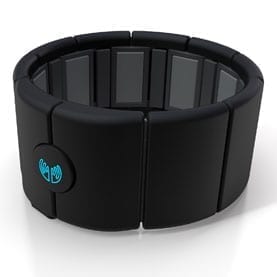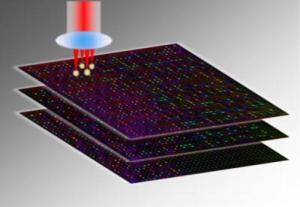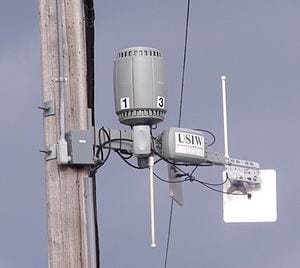
The MYO armband translates electrical activity produced by muscles into commands for gadgets
I expected “gesture control” to be immediately intuitive. But as I slip on the MYO—a flexible band that fits around my forearm—a cursor on a laptop in front of me begins somersaulting wildly across the screen, tracking my erratic arm movements. I focus, slow down and try to get a feel for this new tool.
“Move your wrist right—and now left,” instructs Stephen Lake, co-founder of Thalmic Labs of Waterloo, Ontario, the start-up behind the MYO (named after a biological prefix denoting muscle). As I do, the engineering interface on Lake’s computer screen registers a burst of raw data—peaks and dips of scrolling electrical activity produced by my engaged skeletal muscles. Then, the program flashes the words “right” and “left,” confirming that it understood my actions. I’m beginning to get the hang of this.
I’m in a New York City office, where Lake is offering the first hands-on demonstration of the MYO, a new gesture control interface. The armband has insulated electrodes that detect small volts of electricity that muscles produce when they expand, contract or move in any direction. The band transmits those data wirelessly to software, which translates them into commands for a computer, drone or other electronic device. The idea is to control these devices hands-free, and without the need for cameras that would track my motions.
The MYO prototype resembles a clunky bracelet of the type Wilma Flintstone might wear. The final product—the first batch ships out at the end of the year—will resemble a sweatband, Lake says. The prototype is fashioned out of 3-D–printed black plastic, embedded with several muscle activity sensors. They act as electromyographs, or instruments that detect minute electrical signals on the order of microvolts, produced by activated muscles. “The challenge is picking up those tiny muscle activity signals and ignoring all the noise,” Lake says.
An inertial sensor, embedded in one of the MYO’s segments, registers motion made with the arm, such as a rolling wave or a back-and-forth swing. Using a large set of data, Lake and his co-founders applied machine learning to train the MYO to recognize specific signals while canceling out background noise. “What I am impressed with about the MYO is the combination of state-of-the-art pattern recognition and machine learning algorithms to detect gestures, with a strong base of acquiring data,” says Daniel Stashuk, an electrical engineer at the University of Waterloo who has no financial ties to Thalmic Labs, in a phone interview. “Marrying those two things together is quite useful.”
So far, the sensors can recognize around 20 gestures, from a sweeping arm to a clenching fist. On the finest end of the spectrum, the MYO responds to a thumb and finger pinching together. “It’s not that we couldn’t detect smaller motions, but if we did, there would be so many false positives,” Lake explains.
The MYO’s greatest limitation, Lake thinks, is the fact that the user must wear it. If the armband is not wrapped around the forearm, it cannot detect movement. Current challenges to improving the MYO’s performance, he adds, include better defining an intuitive set of gestures that could be applied across a wide variety of applications. The team is also working to refine the MYO’s algorithms to improve balance between sensitivity and false gesture detection.
The Latest Bing News on:
Remotely Control Computers and Drones
- Russia Deploying New AI-Powered Anti-Drone Deviceson April 30, 2024 at 1:43 am
Russia has developed new artificial-intelligence (AI) powered anti-drone devices for use on the battlefield in Ukraine.
- Lethal AI Weapons Are on the Rise. What’s Next?on April 29, 2024 at 5:00 am
The development of lethal autonomous weapons (LAWs), including AI-equipped drones, is on the rise. The US Department of Defense, for example, has earmarked US$1 billion so far for its Replicator ...
- TU Munich: Robots and drones to monitor and clean the environmenton April 27, 2024 at 11:17 am
Researchers at the Technical University of Munich have set themselves the goal of cleaning the environment with robots and drones. This is done remotely.
- Here’s Our First Close Look At A Ukrainian Light Aircraft Turned Long-Range Kamikaze Droneon April 26, 2024 at 6:48 am
Images shared on social media provide an unprecedented look at one of the light aircraft turned into one-way drones by Ukraine. On Apr. 26, 2024, images ...
- Resisting Enemy Drone Jamming Attempts: Red Cat, Doodle Labs Electronic Warfare Tests in Ukraineon April 25, 2024 at 12:43 pm
Red Cat and Doodle Labs Triumph in Electronic Warfare Tests in Ukraine: collaboration demonstrates enhanced anti-jamming capabilities for drones amid ongoing military challenges. Red Cat Holdings, Inc ...
- Framework’s repairability philosophy is set to expand beyond the laptopon April 23, 2024 at 7:01 am
Framework Computer was ahead of the curve. The company was founded in 2019, as 20 U.S. states began exploring potential right to repair bills. It delivered its first product, the Framework 13, in 2021 ...
- The Ukrainian drones taking on Russia’s Black Sea fleeton April 22, 2024 at 3:05 am
Standing on the shores of a lake with a remote control, a Ukrainian soldier trained his eyes on a small and seemingly innocuous grey vessel as he guided ...
- How car gangs steal 356 cars every DAY using high-tech tricks including GPS jammers, computer-hacking kits and droneson April 20, 2024 at 1:46 pm
ONE car is stolen every 240 seconds in the UK, with thieves using hi-tech robbery kits including computer-hacking devices, GPS jammers and drones, we can reveal. Experts warn that we are in the ...
- Anti-drone defense tech startup Allen Control Systems raises $12Mon April 18, 2024 at 12:51 pm
Austin-based defense tech startup Allen Control Systems said April 18 it has raised $12 million in seed funding. The investment was led by Craft Ventures. Forum Ventures and Rally Ventures also got in ...
- Window-washing drone takes to the Denver skylineon April 17, 2024 at 4:29 pm
DENVER (KDVR) — Drones are used by many people for many different things these days, from recreation to warfare. One day, Jay Hanna looked up at a tall building with lots of windows and had an idea.
The Latest Google Headlines on:
Remotely Control Computers and Drones
[google_news title=”” keyword=”Remotely Control Computers and Drones” num_posts=”10″ blurb_length=”0″ show_thumb=”left”]
The Latest Bing News on:
Gesture control
- Next-Gen Apple Pencil: Haptic Feedback and New Gestures Expectedon April 29, 2024 at 7:59 am
Apple’s 'Let It Loose' event is just a week away, the company should unveil at least three new iPad Pro models: an iPad Pro and a lengthier iPad Air ...
- ‘I wanted to cry’ – Bruno Guimaraes reveals reaction to incredible gesture by Newcastle fans amid transfer exit rumourson April 28, 2024 at 5:49 am
EMOTIONAL Bruno Guimaraes admitted he “wanted to cry” after an incredible gesture from Newcastle supporters. Fan-favourite Guimaraes, 26, has been a revelation for the Magpies since ...
- AI-Enhanced Touchless Computing Empowers Users to Take Control of Gaming Experienceon April 26, 2024 at 4:50 pm
MotionInput was initially developed by Professor Dean Mohamedally, alongside colleagues and students from UCL Computer Science in 2020 as a means of supporting NHS frontline staff during the COVID-19 ...
- Mikel Arteta and Jurgen Klopp show true colours with class gesture during Prem title raceon April 26, 2024 at 3:08 pm
Mikel Arteta and Jurgen Klopp have both provided long-serving Sky News journalist Jacquie Beltrao with shirts to mark her 32 years with the broadcaster. Beltrao has interviewed the Arsenal and ...
- Doctor Brown: Beturns review – the original clown prince in total controlon April 26, 2024 at 4:51 am
Phil Burgers made clowning hip after winning the Edinburgh comedy award in 2012. Now older, if not wiser, his new show is a little undercooked, but his skill as a performer is undeniable ...
- Emily Henry’s latest novel challenges the romantic ‘grand gesture’on April 25, 2024 at 11:10 am
Her latest release, "Funny Story," fittingly finds its heroine in circumstances both tragic and hilarious. Daphne, a children's librarian, has been dumped by her fiancé, Peter, who left her for his ...
- 18-Year-Old Scaler School of Technology Student Develops Innovative Hand Gesture Control for Racing Gameson April 24, 2024 at 7:20 pm
Ayaan Khan, a first-year Computer Science student from Scaler School of Technology, has developed an innovative hand gesture control system for popular PC racing games. By waving fingers in front of a ...
- Mom has wedding pictures photobombed by daughter’s hilarious vulgar gestureon April 23, 2024 at 2:25 pm
A humoured fan suggested Fallon use the photos for her daughter’s wedding one day. “Welp I’d be screenprinting this on every birthday cake until she got married and then I’d flip the bird in her ...
- Watch: Drunk EasyJet Passenger Loses Control, Throws Punches At Cops And Flight Attendantson April 22, 2024 at 11:57 pm
The irate passenger got out of his seat and appeared to hit a Turkish police officer and a woman member of the cabin crew.
- Mudra Band Upgrades Mac Computers’ User Experience with AI Gesture Mouse Allowing Natural Effortless Navigationon April 17, 2024 at 7:03 am
Enhanced Apple TV Control: The update extends Mudra Band’s capabilities to Apple TV, allowing users to navigate the entertainment platform with ease. Gesture controls transform the viewing experience, ...
The Latest Google Headlines on:
Gesture control
[google_news title=”” keyword=”gesture control” num_posts=”10″ blurb_length=”0″ show_thumb=”left”]











